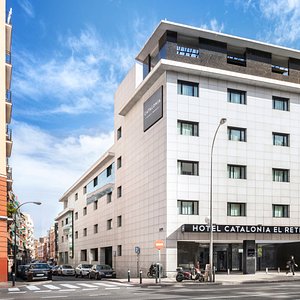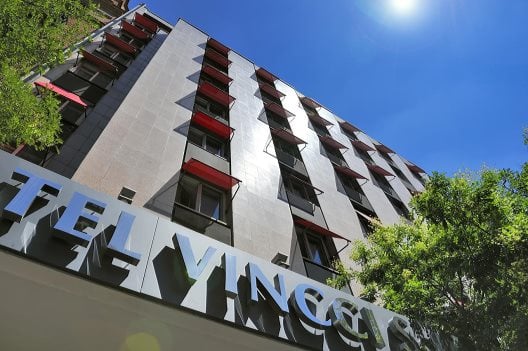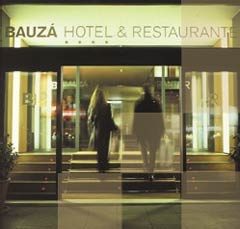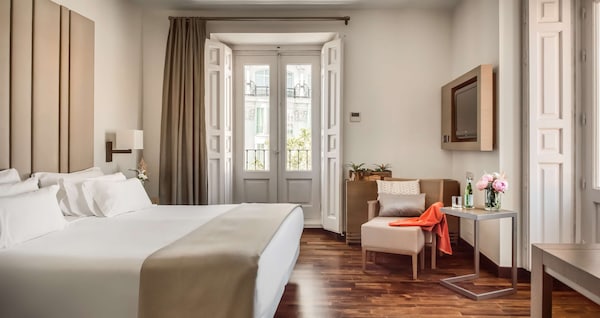Hotel bauza madrid, Ром Дон Папа Бароко, Don Papa Baroko 0,7л. 40% Филиппины

Это даст вам возможность без лишних энергозатрат добраться до продуктовых магазинов Mercadona, Lidl или Eroski , пляжей, баров, автобусов, морского порта, банков и прогуляться вечером возле моря. Spanish sculptors of the mid-late 17th century tended to avoid such excessive naturalism. Isabel realized the meaning of good education and took care of the education of her children by choosing the best teachers.
Гойя и Франция. Goya and France. Якимович А. Испанская ярость. Пикассо в Париже, — Spanish wrath. Picasso in Paris, — Рыков А. Скромное обаяние предательства. Rykov A. Варьяш И. Рыбина М. Христианская церковь в мусульманской Испании. The Christian Church in Muslim Spain.
Возгрин В. Исторические судьбы готов в Испании и в Крыму — сходства и различия. Попова Г. Зеленина Г. Конверсо и инквизиция: «мученики» и «монстр». Conversos and Inquisition. Фомина Н.
Двор Изабеллы I Кастильской. The Court of Isabel I of Castile. Юрчик Е. Крылов К. Карл V в зеркале личной корреспонденции и своей автобиографии. Усунарис Х. Кометы и звезды в политическом дискурсе начала Тридцатилетней войны в Испании. Ведюшкин В. Двор Филиппа II. The Court of Philip II.
Волосюк О. Образ Востока в документах испанских католических миссионеров в эпоху Филиппа II. Дейя Бауса М. Средиземноморская политика Филиппа III. Гонсалес Майя Х. Хименес Патон: о бедствиях, святых крестах и еретиках. Крутицкая А. Popular Religiosity in the Testimonies of the Inquisition 17th—18th Centuries. Латаса П. Тридентский дискурс о свободе вступления в брак в испанском Перу: между законом и жизнью. Хаинова А. Сидоренко Л. Испания в международной политике Великобритании — гг.
Spain in Foreign Policy of Great Britain in — Петрова А. Чрезвычайное посольство герцога де Осуны в России: взгляд современников и историков. Фомичева А. Философия истории в прозе Хосе Хименеса Лосано. Пленков О. Международная помощь франкистам и республиканцам в гражданской войне: сравнительный анализ. Кирсанова Н. Образ борца за независимость в испанской патриотической публицистике — Кожановский А. Политика и этнический фактор в Испании. Politics and the Ethnic Factor in Spain.
Игнатьев Р. Galicians: Issues of Identity in the 20th — Early 21st Century. История и культура России. Самбриан О. Латорре Х. Испанский язык Spanish language 1. Шашков Ю. Античная ономастика в испанском и русском языках. Зеликов М.
Мёд Н. Семантическая сфера «Музыка» в испанской фразеологии и паремиологии. Войку О. Создание инокультурного колорита при переводе. Creation of National Peculiarity in the Translation Process. Соколова К. О некоторых особенностях цветообозначений в испанском языке на фоне других романских языков.
Якушкина К. К вопросу об эвфемистическом употреблении местоимений в испанских политических текстах. Литус В. Гендерная и политкорректная лексика в испаноязычной публицистике и официальных документах. Романов Ю. Образное мышление сквозь призму фразеологии: русско-испанские параллели. Шалудько И. Лингвистические механизмы создания консепта в творчестве Бальтасара Грасиана.
Бурак М. Силюнас В. Визуальная картина мира и театр Золотого века. Мата Индурайн К. Донья Менсиа де лос Нидос, женщина на арауканской войне через призму «Испанской воительницы» Рикардо де Туриа. Гонсалес-Баррера Х. Ключи к пониманию драматической обработки любовно-авантюрного жанра. Пискунова С. Репрезентация как тема и поэтологический принцип творчества Сервантеса. Светлакова О. О специфике двойного героя в «Дон Кихоте». Корконосенко К. Сравнительный анализ двух «живых» переводов «Дон Кихота» XX века.
Миролюбова А. Сервера Баньо Х. Гонгора в испанской романтической поэзии. Баррера Т. Экфрасис в пасторальной новелле о Непорочном Зачатии в Мексике.
Гарау Х. О свободной воле и религиозной ортодоксальности в Persiles. On Free Will and Orthodoxy in the Persiles. Фернандес Москера С.
Сценическое и драматическое пространство в экспериментальном сочинении Кальдерона: премьера пьесы «Три великих чуда». Матвеева Е. Миф о доне Карлосе: Альфьери, Шиллер, Верди. Литература ХХ века Literature of 20th century 1. Родосский А. Основные особенности галисийской поэзии. The Main Peculiarities of Galitian poetry.
Алташина В. Паскаль и Унамуно. Pascal and Unamuno. Абрамова М. Зернова Е. Сантьяго Русиньол и Рамон Казас, выдающиеся фигуры каталонского модернизма. Николаева О. Салвадор Эсприу: каталонский поэт XX века. Salvador Espriu: a Catalan Poet of the 20th Century. Гарсия Руис В. Драматург в сети Web: Виктор Руис Ириарте. Her works on the history of Spanish art, without doubt, are a whole epoch in the studies of Spanish Art.
This epoch covers the entire second half of the 20th century and the beginning of the 21st century. Tatiana Pavlovna has contributed much to the studies of the 17th century art. She published a number of research works about Velazquez and wrote a chapter on the 17th century for The General History of Art. It was Tatiana Pavlovna who wrote the first research about El Greco in this country.
In accordance with the traditions of the Moscow school of the history of art, following her predecessor K. Malitskaya, Tatiana Pavlovna studied all aspects of Spanish Art: architecture, sculpture, monumental and easel painting, crafts, and the art of gardening.
The realistic tendencies of Spanish Art, its democratic roots and the original Hispanic art tradition have always been in the centre of her attention.

In the new conditions of Perestroika and Post-Perestroika, Tatiana Pavlovna has preserved the old values of art understanding and added the criteria of art perfection to the semantic criteria. Kaptereva is an unsurpassed master of the history of Spanish art; her works on this subject are distinguished, on the one hand, by wide horizons and, on the other hand, by harmony and the consistent picture of Spanish art, as well as by clearly exposed logic of its development.
On behalf of the Organization Committee of the conference, we are happy to congratulate Tatiana Pavlovna on her anniversary. We sincerely wish her long active life and success in her future research.
Сфера научных интересов Татьяны Павловны обширна и охватывает разные временные периоды от античности до современности и разные национальные культуры. Но искусство Испании всегда было и остается в центре внимания Татьяны Павловны.

Ее труды по испанистике, без сомнения, — целая эпоха в изучении испанского искусства, охватывающая всю вторую половину XX — первые десятилетия XXI в. Ключевые слова: Каптерева Т. This epoch covers the second half of the 20th century and the beginning of the 21st century. Keywords: Kaptereva T. It was composed of a large number of pictures by the great masters of Spanish art, among them 15 compositions by Murillo, 7 by Ribera, 20 by Zurbaran, 7 by Alonso Cano, a number of pictures by elder and junior Herrera, etc.
The auction lasted three days; the total sales exceeded 1. The crowned heads from all over Europe contended for the chance to own the masterpieces. As a result, many Spanish masterpieces, which the French public had come to consider as part of their cultural patrimony, were taken abroad and never returned.
This purchase had been applauded by the French as if it was a national victory. A great lover of art, Soult had recourse to robbery. He was not the only military leader, who resorted to robbery during the Napoleonic campaigns, but according to some sources, Soult was doing it especially in cold blood and without mercy.
A prominent statesman of the Restoration and the July Monarchy, Soult was proud of his gallery of Spanish painting. Paintings of Spanish masters had become a source of inspiration for such French artists of the Romantic era as Delacroix, Chasseriau, Corot, etc. The Spanish art collection of Marshal Soult made a veritably great impact on the discovery of the great masters of Spanish classical painting by French artistic circles.
They were almost unknown in France at the beginning of the 19th century, and rumored to be gloomy, God-fearing, unaesthetic and ecstatic. However, a few decades later, things had changed radically.
Автор: Гончарова Татьяна Николаевна, кандидат исторических наук, старший преподаватель, кафедра истории Нового и новейшего времени, исторический факультет, СПбГУ, СанктПетербург, markicha yandex. Испанская живопись была почти неизвестна во Франции в начале XIX в. Тем не менее, несколько десятилетий спустя отношение к ней кардинально изменилось. Полотна испанских мастеров стали источником вдохновения для французских художников, таких как Делакруа, Шассерио, Коро и др.
Картинная галерея Сульта, открывшая свои двери в конце х гг. Благодаря ей французские ценители прекрасного получили возможность познакомиться с творениями Мурильо, Риберы, Сурбарана, Алонсо Кано, Эрреры и др. После смерти ее владельца в г. Некоторые увидят в этом справедливое возмездие за грабительские методы, коими Сульт приобрел картины между и гг. Однако, несмотря на короткое существование, картинная галерея Сульта и широкий успех, которым она пользовалась среди любителей искусства, имели длительное воздействие на историю живописи.
Ее влияние сказалось, прежде всего, на живописной манере французского романтизма, а затем через Эдуарда Мане нашло отражение в творчестве многих современных художников. Paintings by Spanish masters had become a source of inspiration for such French artists as Delacroix, Chasseriau, Corot, etc.
Some would see this as a fair punishment for the predatory practices used by Soult to get hold of those paintings between and A magnificent collection of luster-painted ceramics belongs to the department of the Western European applied art.
It comprises vases, bowls, albarellos and dishes, some of them bearing arms of famous historical personalities. There are dozens of specimens, some produced in Andalusia and the others in different workshops of Valencia.

The main body of them came to the Hermitage in as a part of the acquired Basilevsky collection. Later the objects from the Museum of the Society of the Promotion of Arts were added, along with the artifacts from Botkin collection and from Stieglitz museum Although it belongs to the Alhambra type, it was made in Malaga.
Found in by the Spanish artist M. Fortuni, it was later bought by A. The Hermitage numismatics department owns a rich collection of golden, silver and copper coins of Caliphates of Cordova and Granada. It contains rare golden dirhams of Umayyad and Nasrid dynasties. Some coins come from Counts Stroganov famous numismatic collections, acquired by the museum in The Oriental department has architectural details of marble capitals of columns and wood midth century carved consoles ; the latter are supposed to come from the Court of the Lions in Alhambra.
The depiction of lotus on one of these consoles has the same iconography as the floral pattern on a fragment of Alhambra textile that is also kept in the Hermitage. The capitals of columns came to the Hermitage from the Museum of the Academy of Art. The historian N. Kondakov probably means the purchase of these details when he tells about the acquisition of five Nasrid capitals from the garden of the former Alhambra mosque by the Russian architect P.
Notbeck studied the architectural forms of Alhambra for 10 years while living in Granada. He made numerous drawings that brought him the rank of Academician in , replicas of stucco relieves and even some reduced copies of several halls. In , the Academy of Art created the special Alhambra room, that contained such models of the best halls of Nasrid residence.
Nowadays, a part of this collection remains in the Academy of Arts; the other part is in the Hermitage. The interest in the Hispano-Moresque art in Russia was a part of romantic liking for the culture of Spain, Granada in particular. Tales of the Alhambra were published in Russia in , and Pushkin wrote his Golden Cockerel based on one of its stories. This interest conduced to the development of the Moresque style in Russian architecture and applied art, that in turn encouraged collecting the authentic artifacts of Hispano-Moresque art.
In this context, the future Hermitage collections were formed. Изложена история их коллекционирования. Коллекционирование памятников испано-мавританского искусства в России развивалось в контексте появившегося в е гг. XIX в. Формирование неомавританского стиля в русской архитектуре, создание «мавританских» интерьеров способствовало производству произведений прикладного искусства «восточного вкуса» и коллекционированию подлинных испано-мавританского памятников.
Ключевые слова: памятники испано-мавританского искусства, Государственный Эрмитаж, люстровый фаянс, ваза Фортуни, нумизматика Омейядов и Насридов, архитектурные детали Альгамбры, архитектор П. There are dozens of specimens, some produced in Andalusia and others in different workshops of Valencia. The interest in Hispano-Moresque art in Russia was a part of romantic liking for the culture of Spain and Granada in particular.
This interest conduced to the development of the Moresque style in Russian architecture and applied art, that in turn encouraged collecting authentic artifacts of Hispano-Moresque art. In this context the future Hermitage collections were formed. Keywords: artifacts of the Hispano-Moresque art, the State Hermitage Museum, luster-painted ceramics, famous Fortuni vase, numismatics of Umayyad and Nasrid, architectural details of the Alhambra, architect P.
Spain, where strong traces of Arabic culture were found everywhere, impressed Irving highly. In Granada, he walked around the Alhambra all days, observing the fantastic fortress-palace of Mauritanian sultans, which is considered one of the world miracles.
Everything there was filled with tales and legends of the East. Irving saw Granada as one of the legendary Mauritanian-Spanish places on the Peninsula. Here, in Granada, Irving collected old stories and gracefully told them in the form of romantic novellas.
By , when he came back to the USA, he wrote 31 novellas, and each can be considered a separate composition. But he was interested not only in the past, but also in the present of Spain.
He tried to understand the Spanish national character; every person he met was a whole world for him. The largest part of Tales of the Alhambra consists of collected legends.

Novellas, included in Tales of the Alhambra, can be divided into Arabic, Arabic-Spanish and those based predominantly on Spanish materials.
Nevertheless, every novella opens to the reader a peculiar world of Spanish history and culture. Ирвинга, посвященные Альгамбре. Испания, особенно Гранада, где повсюду встречались живые следы арабской культуры, потрясла В. Большую часть его «Альгамбры» составляют собранные легенды. Каждая из новелл вводит читателя в необычный мир испанской истории и культуры. Summary: The article deals with the novellas of one of the classics of the American literature W.
Irving dedicated to the Alhambra. Spain, especially Granada, where strong traces of Arabic culture were found everywhere, highly impressed W. The largest part of his Tales of the Alhambra consists of collected legends. Each novella opens to the reader a peculiar world of Spanish history and culture.
By the beginning of the 16th century, Spain had several famous universities. Among the new ones was the University of Complutum. In the field of theology, the University of Salamanca played the leading role. The thinkers of the Salamanca School of the 16th century were famous not only in Spain, but also all over the world. The Spanish Dominicans are known to have played an important part in the preparation of the Council of Trent, and during its work — The most important contribution of Spain into the development of education in the Old and New World was the establishment of the Society of Jesus that created the pedagogical model and culture that was developing during the 16th—— 18th centuries.
Jesuits and to a lesser extent Franciscans and Dominicans in their scholastic research and educational activities integrated the Middle and Modern Ages and gave the examples of syntheses of various spheres of knowledge. At the turn of the 16th——17th centuries, Jesuits created treatises that dealt with philosophy as a system Suarez, Fonseca, Coimbra scholastics.

Испанская схоластика Золотого века — одна из важных страниц европейского мышления. К началу XVI в. Испания располагает несколькими крупными университетами. Из новых важную роль играет Университет Комплутума, основанный в г. Если говорить о теологии, то первенство было за Саламанкским университетом, который называли «Испанскими Афинами».
С именами доминиканских докторов этой школы Виториа, Сото, Кано, Баньес и др. Известна роль испанских доминиканцев в ходе подготовки и работы Тридентского собора и во время его работы — Иезуиты, в меньшей степени францисканцы и доминиканцы, в своей схоластической научной и образовательной деятельности связали в одно целое Средневековье и Новое время, дав примеры фундаментальных синтезов различных сфер знания.
Остается только сожалеть, что ставшая в XVII столетии более капризной и светской культурная среда, «сузившаяся» «социальная база» схоластики и старомодный стиль изложения философских курсов оттеснили профессоров-схоластов на периферию интеллектуальной жизни и привели в конечном итоге к летнему забвению испанской схоластики, в то время как этот духовный багаж мог бы существенно облегчить жизнь многих «интеллектуальных путешественников» XIX, XX и начала XXI в.
Автор: Шмонин Дмитрий Викторович, доктор философских наук, профессор, проректор по научной работе, Русская христианская гуманитарная академия, Санкт-Петербург, shmonin rhga. В докладе рассматриваются некоторые причины того, почему именно Испании была уготована роль центра схоластического ренессанса в эпоху контрреформации и раннего нового времени. Petersburg, Russia, shmonin rhga.
This contribution deals with some reasons of why Spain was assigned the role of the centre of the «Scholastic renaissance» of the epoch of the CounterReformation and the Early Modern age. It includes the well-known architectural monuments, such as the Cathedral of Seville and the monastery church of San Juan de los Reyes in Toledo. The ecclesiastical architecture of the period is notable for a variety of styles, a complex synthesis of old traditions and new trends, national characteristics and foreign influences.
This synthesis in most monuments was performed very skillfully. Meanwhile, this topic has not been sufficiently studied in the Russian and foreign history of art. The late Gothic period in the Spanish church architecture covers the 15th—16th centuries. This time summarized the quest of the Middle Ages, while the new art, the Renaissance, was coming into being.
These factors had a significant impact on the church architecture. In the late Gothic period, the Spanish church architecture became able to process borrowings from the outside in the spirit of national traditions. Architecture of different regions became uniform in style. First of all, it can be said about the monuments of the 16th century — the time when the national Gothic style became prevailing in the Spanish church architecture.
The cathedrals in Segovia and Salamanca are remarkable examples of this style. Historical events were reflected in the elements of church decoration and, less directly, in the appearance of a number of buildings — mainly urban councils the cathedrals , that are notable for greatness, emotional elation, integrity of purpose. There can also be individual architectural elements — arches, portals, spikes, etc.
The sacred Spanish architecture of the 15th—16th centuries is represented by a number of styles, in many ways similar to each other, and at the same time having a number of specific, recognizable traits. In the 15th century, there was an active borrowing of elements of late Gothic architecture of the Nordic countries. Spain invites a number of artists from Germany, the Netherlands, Burgundy.
At the turn of the 15th—16th centuries the creative processing of these influences, combined with the national traditions and Renaissance motifs led to the emergence of Isabelino, Plateresque and the national Gothic style. The correlation of foreign influences and traditions in the medieval Christian Spanish architecture is an important and interesting topic, but it demands understanding of the impact and influence of the Moorish architecture.
Careful analysis and comparison of buildings in Spain and other countries of Christian Europe with the Moorish architecture shows that the research in this field has been insufficient. Автор: Яровая Марина Сергеевна, лектор-искусствовед, Государственный музей изобразительных искусств им. Пушкина, Москва, marina-june mail. Стиль поздней готики представлен архитектурой больших городских соборов, монастырских и приходских церквей, погребальных капелл.
Среди них такие прославленные памятники, как соборы Севильи и Сеговии, церковь монастыря Сан Хуан де лос Рейес в Толедо, Королевская капелла в Гранаде и капелла Кондестабля в соборе Бургоса. Храмовая архитектура Испании этого времени демонстрирует как использование заимствованных извне приемов и форм, так и творческую их переработку в соответствии с национальными вкусами и традициями.
Так возникают стили исабелино, платереск и стиль национальной готики. Постепенно наряду с элементами готического стиля в арсенал архитектурных форм и элементов декора начинают включаться ренессансные мотивы.
Наконец, в архитектуре и декоре целого ряда позднеготических храмов Испании нашли отражение такие важные события, как политическое объединение страны или завершение Реконкисты.
Ключевые слова: поздняя готика, церковная храмовая архитектура, соборы Саламанки, соборы Севильи, соборы Сеговии, исабелино, платереск, стиль национальной готики, Средние века, Ренессанс, монастырская церковь Author: Yarovaya Marina Sergeyevna, lecturer and guide, The Pushkin State Museum of Fine Arts, Moscow, Russia, marina-june mail.
They include the well-known architectural monuments, such as the cathedrals in Seville and Segovia, the monastery church of San Juan de los Reyes in Toledo, the Royal chapel in Granada and Chapel del Condestable in the cathedral of Burgos.
The ecclesiastical architecture of the period is notable for a complex synthesis of national characteristics and foreign influences. In the late Gothic period, Spanish church architecture processed borrowings from the outside in the spirit of national traditions.
This creative processing, combined with Renaissance motifs led to the emergence of Isabelino, Plateresque and the national Gothic style. The elements of church decorations and, less directly, the appearance of a number of buildings reflect historical events, such as the victorious end of the Reconquista, the final unification of Spanish lands and the turning of the country into a strong centralized state. It is probably most evident when we look at the history of science.
Michael Servetus Miguel Servet , an antitrinitarian philosopher, known as the first victim of Calvinism, left Spain in the age of 15 and never returned. He spent most of his life in France and never wrote a word of praise about his motherland. His anniversary was celebrated widely, his works were edited and translated, and his biography and heritage is studied in several institutes.
There might be many reasons for this attention, but the most evident one lies in the sphere of the history of science. The Spanish Renaissance is famous for its outstanding culture, but it gave no world-known names in science, particularly in medicine.
Spanish medicine needed somebody to be proud of, and Servetus gave the material for constructing a cultural myth. That is why, until nowadays Spain is the only country where the discovery of lesser blood circulation is undoubtedly attributed to Servet.
This discovery was forgotten and became known only on the middle of the 17th century. Now there are strong arguments against this version. First argument is an Arab manuscript dated to the 13th century, in which a Syrian physician Ibn an-Nafis described the minor circulation. The second argument is that Servet, having described the pulmonary circulation, did not give any arguments in favor of his version that can be adopted by the modern science.
An important question discussed in the 16th century was if nobility was the result of inheritance or personal worth. Nevertheless, the same palace has other rooms with frescoes proving his nobility by birth. This paper is devoted to the second type of images. These paintings are especially interesting as they represent a very rare example of the Spanish debate concerning nobility by virtue and nobility by birth.
Аннотация: Важной проблемой, обсуждавшейся в XVI в. Альваро де Басан, знаменитый адмирал испанского короля Филиппа II, посвятил львиную долю фресок в своем дворце в Эль Висо г. Однако в этом же дворце имеются и залы, посвященные доказательству его благородства по рождению.
Наш доклад посвящен этим последним типам образов. Фрески трех залов дворца Альваро де Басана показывают возникновение семьи, ее прародителей и их потомство вплоть до отца Альваро. Этот живописный ансамбль необычайно интересен ввиду того, что он является одним из очень редких примеров испанской дискуссии о благородстве по добродетели или благородстве по крови.
The image of suffering Jesus, that inspired spiritual authors of the 16th century, is one of the most profound embodiments of the image of the God-man in Western European art. For them, the ideas expressed in treatises on meditation formed the foundation of their inner life. Morales began to paint Christ carrying the cross at the early stages of his activity s.
During the s, the artist created works for retablos and individual worship in private chapels. The painting inspired numerous imitations and was well known on the Iberian Peninsula in the s.
As compared to the original, Morales intensified religious exultation and emotional tension. His interpretation was directly influenced by the Spanish spiritual literature of the period. The special painting technique enabled the master to embody the mystical spirit of his time, while most of his contemporaries limited themselves to the search for formal canons in art, contrary to the spirituality ingrained in that period.
В религиозно-мистической литературе XVI в. Игнасио де Лойола, Хуан де Авила, Луис де Гранада, Педро де Алькантара постигли глубинный символический и аллегорический смысл темы «Via Crucis», связанный с «внутренней религиозностью» и личным спасением. В «Трактатах о молитве и размышлении» Луиса де Гранады и Педро де Алькантары приведены чрезвычайно выразительные описания этого «жестокого спектакля», обращенного к чувствам человека.
Образ страдающего Иисуса, вдохновивший духовных авторов XVI в. Заказчиками художника были представители высшей церковной и светской иерархии, тесно связанные с выдающимися писателями и проповедниками, для которых идеи, выраженные в трактатах по медитации, являлись основой внутренней жизни.
Тема «Несения Креста» появляется в творчестве Моралеса на раннем этапе творчества е гг. На протяжении х гг. Три картины ок. Осуны, из старинной коллекции Бонавентуры Грассес-и-Эрнандес Барселоны и монастыря францисканок кларис г. Монтихо, авторские варианты — имеют прямую связь с композицией Себастьяно дель Пьомбо «Христос, несущий крест» — , созданной для Фернандо де Сильвы, IV графа де Сифуэнтеса — , и приобретенной Филиппом II для Эскориала.
На Пиренейском полуострове картина была известна в е гг. По сравнению с первоисточником у Моралеса усилена религиозная экзальтация и эмоциональная патетика.
В отличие от традиционной иконографии средневековых мастеров, изображавших «Крестный путь» с брутальным реализмом, живописец из Бадахоса акцентировал внутреннее содержание события, подчеркнул душевные страдания Христа. На характер решения сюжета оказала прямое воздействие духовная литература Испании рассматриваемой эпохи.
Особая живописная техника позволяла мастеру воплотить мистический дух своего времени, в отличие от искусства большинства его современников, за исключением Эль Греко, ограниченного поисками формальных канонов, противоположных той духовности, которой жил век.
Автор: Калугина Елена Октябрьевна, старший научный сотрудник, государственный музей-заповедник «Царское Село», Пушкин, elena-kalugina mail. Проведен сопоставительный анализ различных вариантов решения сюжета в творчестве мастера из Бадахоса и художников XVI столетия.
Рассмотрено влияние духовной литературы Испании данной эпохи на характер трактовки темы. Various versions of this subject in the works of the artist from Badajoz and other painters of the 16th century are analyzed. The influence of Spanish spiritual literature of the period on the interpretation of the theme is shown.
The representatives of the painting school of the Escorial were Italian and Spanish painters. The Italian painters played the most important role due to the popularity of Italian art and personal preferences of the Spanish monarch Philip II, who ordered the Escorial to be built. The Spanish painters took secondary role and helped the Italian painters. Jerome gave very detailed information about Juan Fernandez Navarrete.
Живописные произведения Эскориала в совокупности представляют собой школу живописи Эскориала. Представителями данной школы были испанские и итальянские художники. Главенствующую роль играли итальянские мастера. Ведущая роль художников из Италии была связана с популярностью итальянского искусства и с личными предпочтениями испанского монарха Филиппа II, по приказу которого был возведен монастырь.
Испанские художники играли второстепенную роль, в основном выступали в роли подмастерьев. Среди испанских художников наиболее выдающимся был Хуан Фернандес Наваррете, из-за своей болезни прозванный Эль Мудо немой. Хуан Фернандес Наваррете Эль Мудо родился в Испании, но сумел посетить Италию, где познакомился с искусством итальянских мастеров.
О Наваррете и его работах наиболее достоверным является источник XVI в. В чем нюансы различий от эпох, где родительству почти всегда диктовалось одно и то же предназначение?
Над этими вопросами необходимо размышлять, прежде всего опираясь на клинику сингулярности субъекта, но с выявлением неких тенденций, трансформирующих логику символического.
La famille suivra! Добавить к сравнению. Артикул: bdg Осталось 3 штуки. Оплата онлайн. Система накопичувальних знижок! Catedratico Soler, 27, Alicante. Пока отзывов нет Оставьте первый комментарий! Оставьте отзыв об этом товаре первым! Рекомендуем посмотреть Сравнить все. Ром A. Riise Gold Medal , 0,7л.